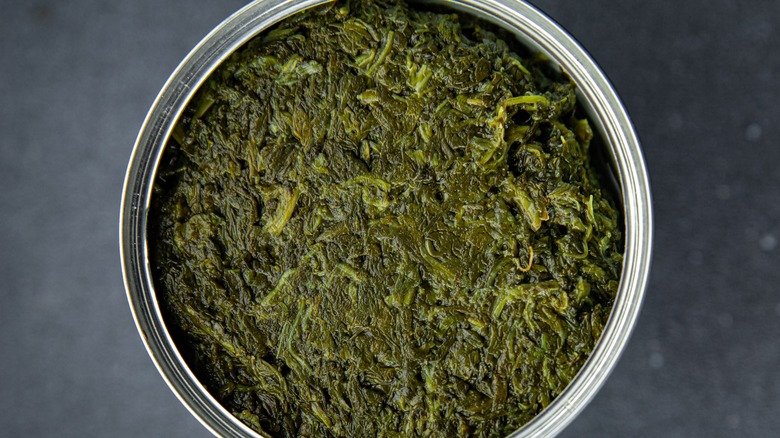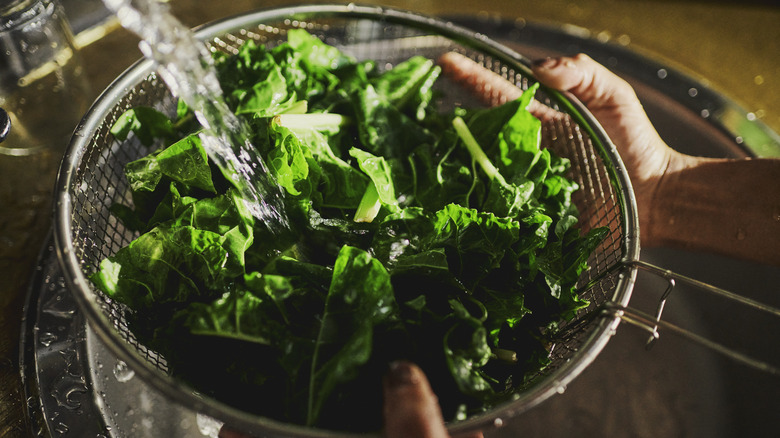The Biggest Mistake You're Making With Canned Spinach
Canned spinach is a convenient, shelf-stable source of a nutrient-dense vegetable that can last up to five years when properly stored in a cool, dry place. Whether you're making a bite-sized leafy green quiche or creamy artichoke dip, canned spinach is a utilitarian ingredient that has a place in many breakfast, lunch, and dinner recipes. Despite its easy-to-use nature, you might be making a big mistake when cooking with canned spinach. If you're not draining and rinsing canned spinach before introducing it to your favorite recipes, you're also reducing the flavor quality and texture of the dish.
Although life would be much simpler if you could dump canned spinach into a pot and get to cooking, your meal will have a much fresher and more balanced taste if you take the time to drain and rinse the greens. Canned spinach is often packed with high levels of sodium and preservatives that can throw the flavor profile of your meal out of wack. Although salt is a flavor enhancer necessary in small amounts in most recipes, if you've taken a forkful of too-salty food to the face, you know that it's not exactly a toothsome bite. Draining and rinsing canned spinach reduces that heavy load of salt by up to 10%.
It's not just the sodium and preservatives that can affect your recipe, it's the liquid too. Too much liquid in a recipe can leave it soggy, so draining the liquid is essential, especially in dishes that aren't spoonable like casseroles and dips.
How to drain and rinse canned spinach
Cooking with canned spinach is all about ease, and draining and rinsing it doesn't have to complicate the process. But even simple kitchen routines come with guidelines, so keep a few pointers in mind to get the most out of your canned spinach.
First, consider your options for tools. A fine mesh strainer or colander are common kitchen utensils that work great for draining and rinsing canned spinach. Just make sure the gaps in your colander are narrow enough to keep the spinach from falling through the bottom. Once you've drained the liquid from the can, rinse with cool water to remove any residual sodium and preservatives. The longer you rinse the spinach, the more sodium will come off.
When rinsing canned spinach, be gentle. Because it is a delicate leaf, and the canning liquid makes it even more so, avoid pulverizing it with water. Use a low-force stream from the kitchen faucet to rinse canned spinach.
Exemptions for rinsing and draining canned spinach
Draining and rinsing canned spinach is important for preserving the integrity of your veggie-centric dishes. However, it's perfectly safe to consume spinach right out of the can and there are some instances where rinsing it isn't entirely consequential.
Some canned spinach may be packed with seasonings like dehydrated onion and garlic to give the bitter greens some pizzazz. If you purchase a can of seasoned spinach, rinsing the leaves will remove all of its flavor. However, draining is still a good idea if you don't want to upset the texture of your recipe. Canned spinach doesn't always have excessive amounts of salt, and some brands manufacture sodium-free varieties, eliminating the need to rinse the leaves.
Draining canned spinach is almost always advised, but nothing is stopping you from adding a whole can to a veggie stew or any other spoonable dish. If you decide to forgo the draining process, make note of how much sodium is in the can and adjust the amount of salt your recipe calls for to prevent a painfully brackish meal. Similarly, adjust the amount of broth you'll use in a stew or soup depending on how much liquid is in the can.
Outside of these occasional exemptions, it's best to take a couple of extra minutes of your time to drain and rinse a can of spinach. Just because Popeye doesn't do it, doesn't mean you shouldn't either.


